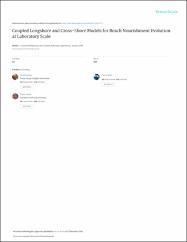| dc.contributor.author | Karasu, Servet K. | |
| dc.contributor.author | Work, Paul A. | |
| dc.contributor.author | Cambazoǧlu, M. Kemal | |
| dc.contributor.author | Yüksek, Ömer | |
| dc.date.accessioned | 2020-12-19T20:12:54Z | |
| dc.date.available | 2020-12-19T20:12:54Z | |
| dc.date.issued | 2008 | |
| dc.identifier.citation | Karasu, S.K., Work, P.A., Cambazoğlu, M.K. & Yüksek, Ö. (2008). Coupled longshore and cross-shore models for beach nourishment evolution at laboratory scale. Journal of Waterway, Port, Coastal and Ocean Engineering, 134(1), 30-39. http://doi.org/10.1061/(ASCE)0733-950X(2008)134:1(30) | en_US |
| dc.identifier.issn | 0733-950X | |
| dc.identifier.uri | https://doi.org/10.1061/(ASCE)0733-950X(2008)134:1(30) | |
| dc.identifier.uri | https://hdl.handle.net/11436/3950 | |
| dc.description.abstract | A series of three-dimensional laboratory experiments on beach nourishment behavior are described and analyzed. The experiments were designed to isolate the influences of berm height, beachfill median grain size, wave height, and wave period. The results have not been scaled up to prototype conditions, but many features of the laboratory evolution have also been observed in previous field studies. Laboratory results indicate that beachfill half-life (time required for half of the added volume to leave the nourished footprint) is inversely correlated with wave height, and positively correlated with berm height. A weak positive correlation with grain size was found. The influence of wave period was inconclusive. A coupled model describing the effects of both longshore and cross-shore sediment transport was developed and applied. The model accounts for the rapid loss of nourishment material offshore via cross-shore sediment transport, followed by a more gradual redistribution up- and downcoast of the project via longshore sediment transport. The influence of cross-shore sediment transport decreases as the beach slope approaches that of the prenourishment beach. The new model has not been calibrated for application at field scales, but it does reproduce the salient features of the laboratory dataset, and previous field data sets, such as the flattening of the beach profile as the project evolves. By describing the position of three elevation contours (berm crest, waterline, and beachfill toe), it thus provides a more realistic alternative to the "one-line" models often applied to beach nourishment problems by accounting for cross-shore sediment transport. © 2008 ASCE. | en_US |
| dc.language.iso | eng | en_US |
| dc.publisher | ASCE Library | en_US |
| dc.rights | info:eu-repo/semantics/openAccess | en_US |
| dc.subject | Beach nourishment | en_US |
| dc.subject | Laboratory tests | en_US |
| dc.subject | Numerical models | en_US |
| dc.subject | Sediment transport | en_US |
| dc.title | Coupled longshore and cross-shore models for beach nourishment evolution at laboratory scale | en_US |
| dc.type | article | en_US |
| dc.contributor.department | RTEÜ, Mühendislik ve Mimarlık Fakültesi, İnşaat Mühendisliği Bölümü | en_US |
| dc.contributor.institutionauthor | Karasu, Servet K. | |
| dc.identifier.doi | 10.1061/(ASCE)0733-950X(2008)134:1(30) | |
| dc.identifier.volume | 134 | en_US |
| dc.identifier.issue | 1 | en_US |
| dc.identifier.startpage | 30 | en_US |
| dc.identifier.endpage | 39 | en_US |
| dc.relation.journal | Journal of Waterway, Port, Coastal and Ocean Engineering | en_US |
| dc.relation.publicationcategory | Makale - Uluslararası Hakemli Dergi - Kurum Öğretim Elemanı | en_US |


















